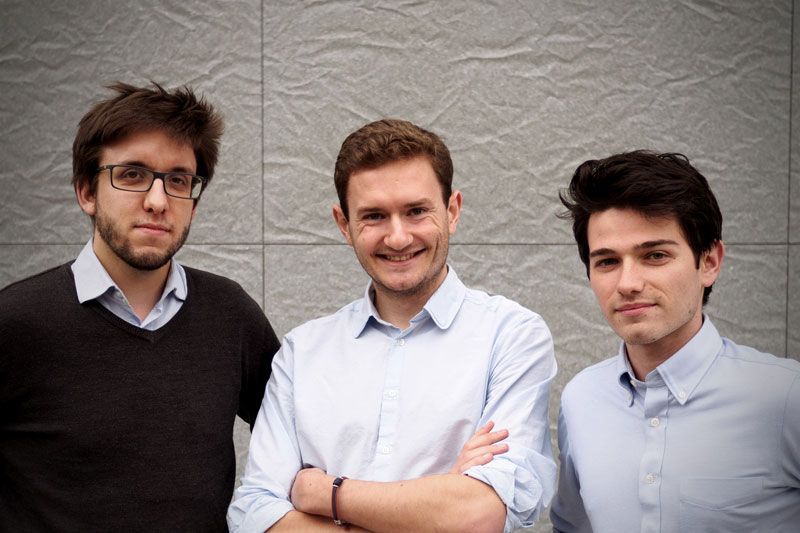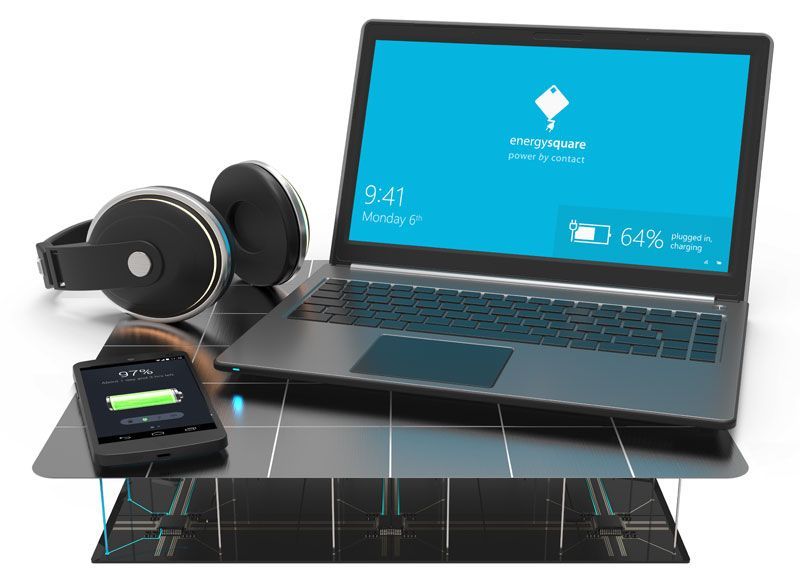Features
No more searching for the charger
03 February 2020
Innovative European SME, EnergySquare, simplifies access to energy with wireless charging technology.

Timothée Le Quesne (centre) and his fellow founders at EnergySquare
With its Power by Contact® patented technology EnergySquare has developed a set of advanced microelectronics and algorithms, allowing people to charge all their devices simultaneously on a single surface, at maximum speed, with no electromagnetic waves and no energy loss.
Smart use of intellectual property is contributing to EnergySquare’s success. The company worked closely with France Brevets on its IP strategy. 4iP Council, speaks to Timothée Le Quesne, company founder, about the company’s experience and plans.
How did the invention of wireless charging come about?
My associate and I were students at the French engineering school Telecom Paris and were engaged on a student project about the future of energy. We wanted to create a new way for device users to charge their devices that is more ergonomic than wires. We realised that existing wireless charging solutions were mainly inductive, resulting significant energy loss, low charging speed and a need for people to place their device precisely over a single point. We wanted people to be able to charge their devices over an entire surface and believed that reinventing conductive charging and making it two-dimensional would be a good way to charge more ergonomically and avoid the inconveniences of inductive wireless charging.
How does the technology work?
Power by Contact is a conductive wireless charging technology. Two electrodes and a receiving circuit are embedded in the device that needs to be recharged and the device is then placed on a charging pad made of conductive tiles. Each tile is linked to different sensors and microcontrollers with embedded algorithms for detection and charge monitoring purposes. This conductive charging technology makes it possible to charge several devices simultaneously on a full surface at the same speed as with a classic charger and with 98% charge efficiency.
What was your approach to developing EnergySquare?
All wireless charging technologies on the market were inductive charging technologies using electromagnetic waves to charge devices. Very low charging efficiency and speed are inherent to this technology. Our goal is to create a new wireless charging standard that is both energy efficient and answers to devices manufacturers’ requirements.

EnergySquare’s Power by Contact® technology
How did you fund your research for the innovation?
France Brevets helped us finance our patent portfolio in the very first steps of development. We then received financial help from Banque Publique d'Investissement (BPI France) and we raised funds with French business angels in 2018.
At what point and why did you consider IP?
IP is crucial to EnergySquare. Our goal is to create a new charging standard which we believe will be embedded in millions of devices. We can’t do that without having strong IP. We developed a patent portfolio very early in our company’s life mainly to protect our innovation and to be able to operate a licensing model.
What advantages does owning IP bring you?
With a licensing model, owning a strong IP portfolio is important for building a strong relationship with customers: our innovation is protected, and our customers are protected when they choose to integrate our technology into their devices. It is also reassuring for our investors and partners.
How are you managing your IP portfolio? Lesson learned?
We have been working very closely with France Brevets to build and manage our IP portfolio. It is a significant expense for a young company, so it is key to find partners to help to finance and expand the very first patents. It is also important to build the patent portfolio with strong prior strategic reflection, to make ensure there is a coherence in the portfolio.
What is the performance and size of the company now?
There are ten of us in the company and we just announced our first technology partnership with Lenovo to embed our technology into the ThinkBook laptops.
How do you see your IP strategy evolving in upcoming years?
We will add new patents to our portfolio each time we develop new features from our R&D lab. We will also consider new geographic coverage depending on our customer needs.
What is the impact of France Brevets’ support in your business development?
Licensing is a difficult step for a technology start-ups to take. It is difficult to convince clients and investors without a strong patent portfolio but it is also impossible to build a portfolio without clients and investors. France Brevets helped us to cross this chasm by helping us finance a strategic patent portfolio. We were then able to convince customers and investors. We are now continuing to build our patent strategy with France Brevets.
What advice would you offer other European inventors, in particular in relation to IP?
It is key to start developing an IP strategy and patent portfolio in the very first steps company development and to find the right partners to develop this IP.
Do you have any advice or suggestions for European policy makers based on your experience as a young innovative European SME?
For deeptech startups, it is very difficult to get funding from VC investors before having a patent portfolio and some commercial traction. As a patent portfolio is quite expensive to develop, scaling a programme such as France Brevets’ Patent Factory up to the European level would make sense.
The views expressed in this feature are those of the interviewee and may not reflect the views of 4iP Council or its members. The purpose of this feature area is to reflect thinking on the topic of intellectual property and enable open discussion.



